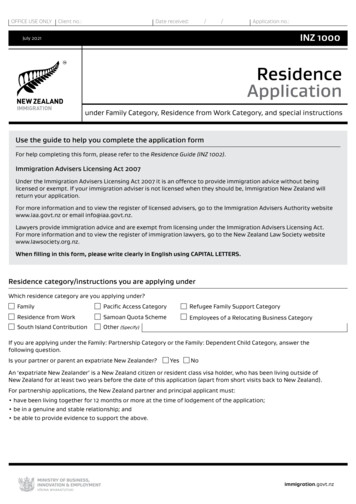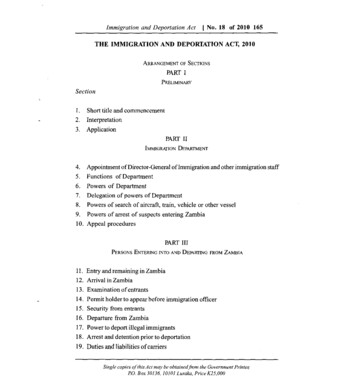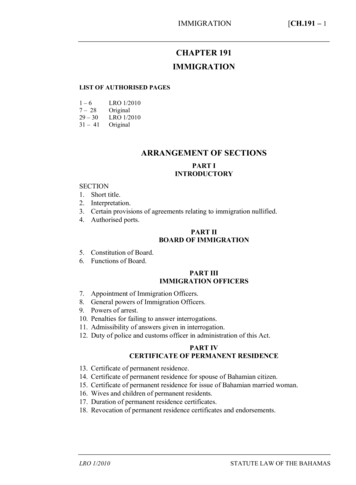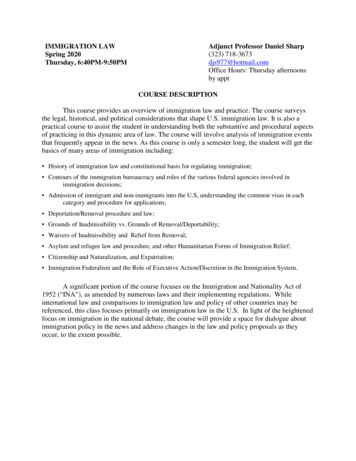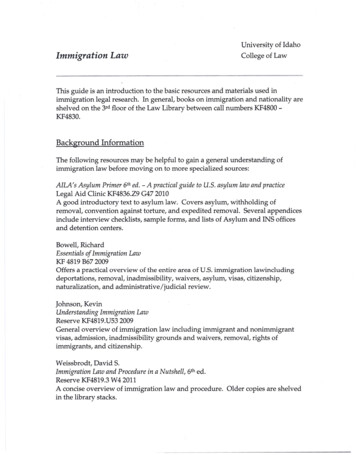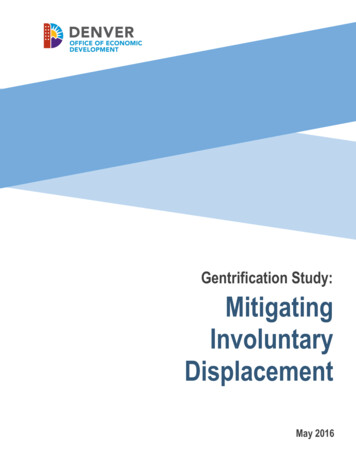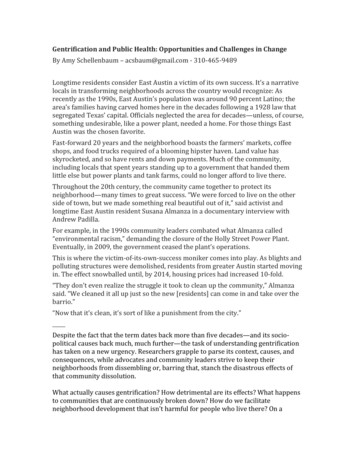
Transcription
Immigration and Gentrification –a case study of cultural restructuring in Flushing, QueensWEISHAN HUANG(Max-Planck-Institute for the Study of Religious andEthnic Diversity, Göttingen)Abstract:The aim of this article is to introduce how culture and economics intertwine inurban re-structuring before and after the 1990 recession in New York City by usingthe case study of Flushing, Queens. My research will bring in a cultural perspectiveto contribute to the understanding of gentrification as economic, social and culturalrestructuring under the impact of international immigration. First, this case ofneighbourhood transfiguration was initially triggered by a private immigrantdeveloper, not a cooperation, whose successes were based on factors includingTaiwanese immigrants’ residential and housing preferences in the 1980s and 1990s.Ethnic residential preference and cultural tastes are cultural factors whichaccelerated gentrification during the early 1990s recession. The residential patternof Asian immigrants in New York has showed the continued concentration of ethnicenclaves since the 1980s. Secondly, there has been diversification in Flushing sincethe 1980s, which is different from the kind of gentrification which creates a social,economic, and racial hegemony in a neighbourhood. The diversification of racesand ethnicities in this neighbourhood has increased since the 1980s through thecontribution of post-1965 and later post-Cold War immigrants, especially thesettlement of Asian immigrants. We need to distinguish between gentrification thatcreates homogenous racial or ethnic communities that push immigrants out, andthis new form of super-diversity gentrification, based on a transnational flow ofcapital that fosters diversity and uses diversity as a form of investment capital.The first aim of this article is to introduce howculture and economics intertwine in urbanre-structuring before and after the 1990recession in New York City by using the casestudy of Flushing, Queens. The early 1990srecession was a turning point for gentrificationin New York, but this turning point has still notbeen satisfactorily explained. Many argue thatgentrification is now fundamentally differentthan it was in the 1970s and 1980s, butoverlook the details of how it works (Lees2000). Others (Bondi 1999; Ley 1996) hintthat the process has changed but provide fewsummaries of what those changes might be.My research will bring in a cultural perspectiveto contribute to the understanding ofgentrification as economic, social and culturalrestructuring under the impact of internationalimmigration. Second, this study also discoversthat there were two waves of diversificationtaking place in Flushing. The first wave wascaused by post-1965 migration and the secondwave by post-Cold War migration. We need todistinguish between gentrification that createsDiversities – Vol. 12, No. 1, 2010: 1-3ISSN e1/art6 UNESCO
D I V E R S I T I E S Vol. 12, No. 1, 2010 ISSN: 2079-6595Weishan Huanghomogenous racial or ethnic communities thatpush immigrants out, and this new form ofsuper-diversity gentrification, based on thetransnational flow of capital that fostersdiversity and uses diversity as a form ofinvestment capital.Many studies focus on the question ofchanges in gentrification before and after the1990 recession and argue that the early 1990sslowdown was actually a precursor toaccelerated gentrification because babyboomers might choose the inner city as a placeof retirement (Lees and Bondi 1995; Ley1996). This assumption raises anotherquestion concerning the rationale of what andhow gentrification takes place in suburbanareas. Indeed, Flushing, located in northernQueens, is a newly gentrified suburban city.Both Mitchell and Hackworth point out thatthe idea is not to simply add culture as anextra autonomous variable in the study ofcities. As Mitchell (1993) said, ‗Treating cultureas an explanatory variable in the production oflandscapes can sometimes downplay the waysin which culture is deliberately produced byeconomic interests to increase the circulationof capital.‘ For example, Mitchell‘s study inVancouver demonstrates how the ethos ofmulticulturalism was deployed and purposelymanaged by wealthy Hong Kong real estateinterests to justify the hyper-valuation of realestate markets in Vancouver, British Columbia.Her research focused on how the actions ofreal estate developers increased land value byusing ethnic culture as a tactic, or whatHackworth and Rekers (2005) have called theperformance of ‗ethnic packaging‘. Based onher findings, Mitchell suggests that culture isneither completely organic nor completelyautonomous in the production of urban space.Hackworth‘s (2002) study on gentrificationpoints to four fundamental changes in the waythat gentrification works in New York City.First, corporate developers are now morecommon initial gentrifiers than before. Second,the state, at various levels, is fuelling theprocess more directly than in the past. Third,anti-gentrification social movements have beenmarginalised within the urban political sphere.Finally, the land economics of inner-cityinvestment have changed in ways thataccelerate certain types of neighbourhoodchanges.Many other case studies in New York Cityneighbourhoods tend to focus on therelationship between gentrification and capitalinvestment in the inner core of New York. Inanother study on citywide inner-city real estateinvestment, gentrification, and economicrecession in New York City, Hackworth (2001)discovered that suburban areas of easternQueens, southern Staten Island, and theeastern Bronx experienced a milder reductionof sales activity during the recession than theinner core. After the recession, the highestHypotheses, Research Questions andResearch MethodThis study examines the interconnection ofcultural preference and economic factors in thegentrificationofFlushing,New York.Gentrification has been defined as theproduction of urban space for more affluentusers. Most studies on gentrification focus oneconomic factors. In the past 15 years, therehave been some debates on both cultural andeconomic factors in urban studies (Barnes2003; Ley 1996). The economic school tendsto look at the demand and supply side. Someargue that the return of gentrification after1990 represents nothing less than areassertion of economics over culture. Recognition of the importance of the cultural factorslowly appears in cases studies, such asHackworth (2001) and Mitchell (1999). Culturehas been recognised as a meaningful – ratherthan a structurally residual – factor in theproduction of urban spaces. A wave of urbanstudies has explored the role of culture in theproduction of cities during the past decade(Mitchell 1999). Yet the divide betweeneconomic or cultural restructuring does notalways provide a complete analytical tool.There is no clear division in many case studies.60
Immigration and GentrificationD I V E R S I T I E S Vol. 12, No. 1, 2010 ISSN: 2079-6595percentage gains in sales activity wereexperienced in the inner core, whereas thesuburban fringe experienced a more limitedrise. New construction activity was relegatedmostly to the suburban fringe of the city –predominately to Staten Island and easternQueens. Much of central Queens experienced adecrease in the number of demolitions duringthe recession, suggesting that disinvestmentthere was slowing. Massive immigrationthroughout the 1990s had kept demand forhousing there strong (Hackworth 2001).The change of centre/periphery growth isdifferent to ethnic concentration in Queens.How do we understand ethnic concentration asin the case of Flushing? Is it white flight, anethnicenclaveorethnicsuccession?Historically, Chinatown has been viewed as anethnic ghetto or minority community. Earlierstudies consider Chinatowns in North Americaas ‗characterized by a concentration of Chinesepeople and economic activities in one or morecity block which forms a unique component ofthe urban fabric. It is basically an idiosyncraticoriental community amidst an occidental urbanenvironment‘ (Lai 1973: 101).Newimmigrants consider ethnic communities to bea shelter within the host society. They obtainethnic social capital by finding documented orundocumented jobs from co-ethnic employersand also find comfort in enclaves due to thelimitation of linguistic dependency and ethnicfood preferences.As for the decrease of the white populationin Flushing, it was partially caused by the oldresidents moving out after selling theirproperties to newcomers for hundreds ofthousands of dollars. ‗White flight‘ is a termindicating the departure of white residentsfrom urban communities as the population ofminority residents increases. Laura Pulidosbelieves that the process of suburbanisationand urban decentralisation contributed tocontemporary environmental racism (Pulido2000). The decline of the white population wasassociated with the increase of the Asianpopulation. In an interview with me, Dr. L. F.Chen, member of the Taiwan MerchantAssociation and member of the board ofdirectors of the Taiwan Center, notes that therewas discontent and conflict with old whiteresidents during the increase of the Asianpopulation in the 1980s and 1990s.‗Ethnic enclave‘ is a term indicating that anethnicneighbourhoodretainsculturaldistinction from a larger, surrounding area. Italso indicates an ethnic business that is run bythe members of the community. Ethnicenclaves may be formed involuntarily, which issimilar to the concept of an ‗ethnic ghetto‘, dueto housing discrimination or the preference ofreligious minorities. What are the initialdecisions establishing a divided ethnicneighbourhood separate from main-streamculture and old Chinatown? In this regard, Iwill elaborate on the history of the building of‗little Taipei‘ in Flushing later. Communitybusiness leaders in Flushing may also findways to promote ethnic enclaves as touristattractions, such as the promotion of the LunarNew Year Parade.Could ethnic enclaves trigger gentrification?Hackworth and Rekers (2005) argue that someof these areas function as abradingmechanisms to produce nearby tions have recognised this attraction andhave begun to manufacture a saleable form ofethnicity to tourists and prospective residentsalike, called ‗ethnic packaging‘ in reference tothe process of gentrification in Canada.Hackworth and Rekers discovered that ‗[t]heseinstitutions actively manage and sell an ethnicidentity that is increasingly at odds with nearbyresidential patterns. The commercial areas ofthese neighborhoods now function less asareas of identification of the stated group, andmore as ways to market each neighborhood‘sresidential real estate markets‘ (Hackworth andRekers 2005: 23). Could packaged ethnicityfacilitate gentrification? Hackworth and Rekerspresent several thriving cases in Canada inwhich they explored the relationship betweenproduced culture and economics in the61
D I V E R S I T I E S Vol. 12, No. 1, 2010 ISSN: 2079-6595Weishan Huanggentrification of ethnically defined inner-cityneighbourhoods (Hackworth and Rekers 2005).While examining social change in Canadianinner cities since 1970, David Ley (1996)hypothesised that the resurgence of themiddle class in downtown areas is linked to thegrowth of professional and managerialemployment in service industries and tofavourablegovernmentpolicies.Leydocuments the emergence of a new middleclass and the origins of their residentialpreferences for downtown neighbourhoods. Heconcludes that neighbourhood movements andreform politics have been elitist, mainly servingthe interests of the affluent new middle class,and that reform politics also foundered due tothe divided interests of the new middle class.Like Ley, the ‗culture school‘ seesgentrification as spatial expression of a criticalclass (Caufield 1994; Ley 1996), built on thenotion of consumer dominance in tastes.According to this view, neighbourhoodsgentrify primarily because tastes andpreferences have changed, including anincreasingly large segment of society thatrejects the suburbs – because of the distanceto work, the isolation, the lack of diversity – infavour of inner-city living (Ley 1996). In thecase of Flushing, gentrification involves thechanging tastes of different ethnicities insteadof simple social classes. The changing tastes ofethnicities refer not only to change inconsumption, but also to changes in valuesand beliefs, etc.The research used in this study involved atriangulation of methods, including ethnography, GIS analysis, and focus groups. Theethnography and focus groups were carriedout during the Ecology of Learning Project between October 2007 and June 2008. GISanalysis was conducted together withDr. Norbert Winnige at the Max PlanckInstitute for the Study of Religious and EthnicDiversity in 2010. United States census datawas used to identify the pattern of ethnicresidential preference.Transfiguration of FlushingThroughout its history, New York has been acity of immigrants and one of the gatewaycities to the United States. The flow ofimmigrants has changed not only thedemographics of New York, but has alsorevitalised some declining neighbourhoods. Myresearch has discovered that Flushing is not a‗satellite city‘ of the traditional Chinatown(Manhattan) as described by sociologist JanLin (Lin 1998). This article argues that the riseof Flushing created a promised land forTaiwanese entrepreneurs in the 1980s and1990s and has more recently become a newcentre for ethnic Chinese immigrants afterSeptember 11, 2001.From 1880 to 1920, close to a million and ahalf immigrants arrived and settled in the city,so by 1910 fully 41 percent of all New Yorkerswere foreign-born (Foner 2007). More thantwo and a half million have arrived since 1965.A survey of New York City households taken bythe US Census Bureau in 1999 revealed that40 percent of the city's 7.4 million people arenow foreign-born. 1 The top five groups in1990 - Dominicans, Chinese, Jamaicans,Italians, and residents of the former USSR –made up just under 30 percent of allpost-1965 arrivals there. In 1998, the top fivegroups were Dominicans, immigrants from theformer Soviet Union, Mexicans, Chinese, andGuyanese.2Asians coming to America, includingChinese, have increasingly settled in Queens,New York. We have witnessed the concentration of Asian residences and the newformation of an Asiantown in Queens. In 2000,half of Asian New Yorkers lived in Queens,where Asians constituted 19 percent of thepopulation. 3 According to the 1990 Census,621U.S. Census Bureau 1990, http://www.census.gov/.2U.S. Census Bureau, March 1998, http://www.census.gov/.3Asian American Federation, http://www.aafny.org/default.asp; U.S. Census Bureau 2000,http://www.census.gov/.
Immigration and GentrificationD I V E R S I T I E S Vol. 12, No. 1, 2010 ISSN: 2079-6595there were 164,586 Asian Americans living inQueens. Among them, 145,362 werepost-1965 arrivals.4 In 1998, the number wentup to 159,973. 5 Asians comprised nearly aquarter of the city‘s post-1964 foreign-bornpopulation (Foner 2000).Since the 1980s, Flushing, Queens, hasbeen the site of a new and revived commercialzone. Its prosperity reflects not only thesuccessful investment of Taiwanese andKorean merchants, but also the formation of anew Asian community with a unique kind ofreligious pluralism. The 2000 United StatesCensus Bureau ranked Queens County as theninth most populous county in the UnitedStates with over 2.2 million residents. 6According to the Census Bureau, QueensCounty experienced an over 14 percentincrease in population since the 1990 census.The 2000 Census also reflected the growth ofthe Asian population in Queens County withover 391,500 people identifying themselves asAsian Americans. More than half of Flushing‘spopulation is Asian American, and many of theneighbourhoods around Flushing also have anincreasing number of Asian Americanresidents. It is also claimed that Flushing hasthe largest ethnic Chinese community in theNew York metropolitan area, surpassing thenumber in Manhattan‘s Chinatown.started by a single Taiwanese immigrant,Tommy Huang. One might expect to see theinvolvement of the state in fostering thistransformation, but, interestingly, the statewas not present in this case. The FlushingBusiness Improvement District (BID) was notestablished until September 2003, disregardingthe protest from small merchants who wereafraid of being marginalised by this transition.The aid of the local government arrived afterthe transfiguration of this neighbourhood.Finally, the anti-gentrification movements wereinitiated by old white residents who had beenmarginalised and eventually moved out of theneighbourhood by selling their properties. Thisis somewhat different from Hackworth‘sdescription of gentrification.Gentrification in the area can be traced to aTaiwanese developer and the savings hebrought with his family from his home country.From the 1930s to the 1950s, theneighbourhood had been predominantly whiteAnglo-Saxon Protestant and most churcheshad large, active memberships. In 1981, therewere only two restaurants in downtownFlushing; in 1998, this area became the fifthlargest shopping area in New York City. Howdid this development take place? One man,Tommy Huang, created a real-estate empire inQueens by constructing hundreds of buildings,a tale begun on Main Street in Flushing. Noone could have predicted that the 27-year-oldHuang would create New York‘s secondAsiantown in the 1990s.There are several reasons for theconcentration and investment of Taiwanesebusiness capital in downtown Flushing. First ofall, starting in the late 1970s, thesefamily-orientedtypeimmigrantsweremiddle-class people who owned private capitaland who emigrated from Taiwan with theirfortunes due to the development of Taiwan‘seconomy. This middle-class population losttheir old business networks when theymigrated, but real estate was still a business inwhich they prospered. Second, in the 1980s, aglobal immigration market where nation-statesA Different Kind of GentrificationTriggered by a Minority GroupThe initial transfiguration of Flushing tookplace in early 1981, before the financialrecession in the late 1980s, and was triggeredby a minority group, Taiwanese Americanimmigrants. Similar to Hackworth‘s description,developers, seeking potential benefit, usuallyinitiated changes. The initiative whichprompted the transfiguration of Flushing was4U.S. Census Bureau 1990, http://www.census.gov/.5U.S. Bureau of the Census, 1990 and March1998.6U.S Census Bureau 2000, http://www.census.gov/.63
D I V E R S I T I E S Vol. 12, No. 1, 2010 ISSN: 2079-6595Weishan Huangcompeted with each other to attract potentialbusiness immigration emerged. Immigrantvisas became ever more available to peoplewith financial resources who were willing toinvest in the host country (Tseng 1997). Themajor question became where they wouldinvest in real estate. Why would Taiwanesenewcomers choose Flushing over Elmhurst,which was also a main destination for manyearly Taiwanese immigrants in New York?Investment in Flushing created one of the fewalternatives to Manhattan Chinatown for manyTaiwanese immigrants, including Taiwaneseoverseas nationalists and individual investors.However, my interview with Tommy Huang, apioneer private developer, unveils the culturallogics that underlie both residential andinvestment preferences for early TaiwaneseAmericans.According to the interviews with TommyHuang and L. F. Chen, Huang‘s vision broughthim to invest in downtown Flushing, adeclining neighbourhood where more than 50percent of shops were closed in the 1980s.Huang started his first development project onMain Street between 37th Avenue and 38thAvenue. He first targeted new Taiwaneseimmigrants based on the calculation of culturaland social capital. Due to zoning restrictions,some land Huang purchased in downtownFlushing was intended for commercial and lightindustry purposes. For commercial zones,office buildings are built and sold for businessquickly. More than half of the commercialbuildings were built by Huang in the 1980s,and later five apartment buildings and onemall. Yet his first success was with commercial-and-residential combination buildings.How could a small developer with only 500,000 transfigure the landscape ofdowntown Flushing? The economic decline ofdowntown Flushing may have provided agolden chance of buying inexpensive land, butit was culture factors that helped Huang sellhis first building even without actually startingconstruction. Huang realised that Taiwaneseimmigrants favoured commercial-and-resi-dential combination housing, as they did inTaiwan. Huang designed the three-storybuildings mixing street-level stores and secondand third levels of residential housing. Ownerscould easily rent the first and second levels tonew immigrants and live on the top level.Many of them might also choose to run smallbusinesses on street-level stores, rent thesecond floor out, and live on the top floor. Thiskind of building design reflected the charactersof Taiwanese as conservative investors whogained the security of owning real estate.Mixing commercial and residential housingalso provided a financial benefit. Legalrestrictions prohibit developers from sellingresidential buildings before they complete thewhole construction. In contrast, New Yorkstate law was more relaxed on commercialbuildings. Huang could actually start collecting10 percent of the down payment by showinghis floor plans to his buyers, and another 10percent after the developers finished partialconstruction of buildings. Therefore, Huang, asa small developer, could create the Flushingmiracle with limited capital within a decade.Huang‘s innovation in real estate development is based on his careful calculation of thecultural habits of new Taiwanese immigrants inthe 1980s and New York State Law. Before the1980s, most Taiwanese and Asian immigrantslived in Elmhurst, Queens, an ethnic enclave,or later, in Long Island for better school districts. Why would Taiwanese and Asians moveto Flushing? I argue that it is because of ethnicresidential preference, cultural taste or culturalpreference. Here I provide two analyses toprove this assertion. The first one is a counter-argument to that of Jan Lin, who regardedthe transfiguration of Flushing as a satellitecity of old Chinatown in Manhattan. Thesecond is an analysis of residential patternsbased on US census data since the 1980s.Lin (1998) argues that the emergence ofsatellite Chinatowns in the outer boroughs ofNew York City is mainly an outcome of congestion in the core Chinatown of Manhattan. AsLin pointed out, the emergence of a gateway64
Immigration and GentrificationD I V E R S I T I E S Vol. 12, No. 1, 2010 ISSN: 2079-6595town conforms with an emerging area of primary settlement for new immigrants to themetropolis. Examples of this are CrownHeights for West Indians and ‗little Odessa‘ inBrighton Beach for Russian Jews. These trendscontrast with classic urban suppositions thatinner-ring suburbs (such as New York‘s outerboroughs) would be areas of secondary settlement for upwardly mobile immigrants (Lin1998).Although Flushing today has become agateway for new flows of labour and capitalthat are leapfrogging the core, I disagree withLin‘s claim that Flushing, which he calls asatellite Chinatown, was initially formed as anarea of secondary settlement. The investmentin Flushing was based on a developer‘s carefulcalculation that Taiwanese immigrants wereseeking a politically, socially, and ethnically different settlement area than that of ‗traditionalChinatown‘, where most of the old settlerswere from Taishan, Canton, and Hong Kong.Lin correctly observed the emergence of asatellite, such as the new Chinatown on EighthAvenue in Brooklyn (or sometimes calledSunset Park Chinatown). This satellite is anextension of both the lower and upper circuitsof the enclave economy; restaurants andgarment sweatshops can be found in satelliteChinatowns as well as transnational banks andforeign investors. Lin also stressed that residential and economic decentralisation on afundamental level is determined by ecologicalvariables of population density, scarcity of housing, and high land values in the urban core.Residential out-movers are additionally motivated by preferences for privacy and space;their outward geographic mobility, enabled byhousehold savings, also reflects upward socialmobility. Economic out-movers follow somewhat in the path of residential decentralisation;small enterprises find that labour is available inMap 1. Asians by track change 1990-2000. Dr. Norbert Winnige and Weishan Huang.65
D I V E R S I T I E S Vol. 12, No. 1, 2010 ISSN: 2079-6595Map 2. Asians in New York 1990, Dr. Norbert Winnige and Weishan Huang.Map 3. Asians in New York 2000. Dr. Norbert Winnige and Weishan Huang.66Weishan Huang
Immigration and GentrificationD I V E R S I T I E S Vol. 12, No. 1, 2010 ISSN: 2079-6595the outer boroughs, and banks similarly findthat residents there have monetary savings todeposit and invest (Lin 1998).In the late 1990s, Flushing received moreand more new Chinese immigrants not onlyfrom southern China but also from botheastern and northern China. Where do theylike to live and whom do they like to live with?Our GIS map tells us that Asians tend to livewith Asians in New York, including in fourAsian concentration neighbourhoods.On this map, besides the heavy concentration of Chinese in traditional Chinatown, Manhattan, Asians tend to choose neighbourhoodswith a high concentration of Asians. Thissimilar residential pattern of Asians can beobserved in the neighbourhoods of Flushing(Queens), Elmhurst (Queens), and Sunset Park(Brooklyn).Map 2 and Map 3 illustrate the process ofconcentration of Asians. US Census data canonly illustrate the special choices for new Asianimmigrants, but cannot tell us more about whothey are and how they make the decisionsabout residential preference. My previousethnography has discovered that Taiwaneseelites and nationalists tend to choose Flushing,Queens, as new settlement because of social,political, and economic reasons. Taiwaneseelites, many of whom have high educationalbackgrounds, preferred to live in Flushing inorder separate themselves from the image oftraditional working-class immigrants in Chinatown, Manhattan. Overseas Taiwanese nationnalists, many of whom were persecuted by theKuomingtang (Muo Ming Party) regime andcould not return to Taiwan, were busy buildinga ‗Little Taipei‘ as a base for political solidarity.The examination of the Asian immigrant profilein Flushing will continue in the next section.ethnic residential patterns in Flushing (alsoSunset Park in Brooklyn). Cultural gentryficationaccelerates and sustains the continued economic gentrification in these neighbourhoods.According to the US census, in 2006, theChinese population made up 57 percent(63,811) of the entire Asian population inCommunity District 7, Flushing. In 2006,Flushing residents in CD 7 were composed of57 percent Chinese, 26 percent Korean, 8percent Indian, 4 percent Filipino and 5percent other Asian immigrants.7Chinese immigrants increasingly moved toFlushing for business and for residence purposes. The building of a ‗Little Taipei‘ in Flushingfaded in the late 1990s as post-Cold WarChinese new immigrants quickly outnumberedTaiwanese immigrants. When post-Cold WarChinese immigrants moved into New York,their presence further diversified the alreadydiverse ethnic communities. Each ethnicsub-group tends to form its own socialnetworks for business and later hometownassociations for political identity and solidarity.New York has witnessed an increased processof diversification of cultural and politicalgroupings among ethnic Chinese communitiesover the last two decades.According to the information from the NewYork City Planning Department, the continuedtrend of neighbourhood gentrification inFlushing continues. The median rent hasincreased from 832 in 2000, to 1095 in 2005and 1160 in 2006, which is almost a 40percent increase in six years. The medianhome value has increased from 269,043 in2000, to 496,500 in 2005 to 535,700 in2006, which is almost a 50 percent increase insix years.8Ethnicity and cultural intimacy among Asianimmigrants are the factors accelerating thegentrification. The capital investment ofThe Investment in a New PromisedLand – the Continued Gentrification ofthe NeighbourhoodThe gentrification of Flushing did not slowdown because of the economic recession. Wesee the pattern of continued concentration of7New York City Department of City w York City Department of Planning,http://www.nyc.gov/html/dcp/home.html.67
D I V E R S I T I E S Vol. 12, No. 1, 2010 ISSN: 2079-6595Figure 1: CD 7 Asian composition 1990-2000. Dr. Norbert Winnige.Figure 2: CD 7 Foreign-born population 2000. Dr. Norbert Winnige.68Weishan Huang
Immigration and GentrificationD I V E R S I T I E S Vol. 12, No. 1, 2010 ISSN: 2079-6595Figure 3: EOL project in 2008.Taiwanese immigrants in downtown Flushing isa significant element in the commercialisationof this area, yet Korean immigrants were alsoinvolved in this hot market (Chen 1992).Flushing was declining in the 1980s, but in theeyes of Taiwanese immigrant developers,Flushing is a place that serves as an importanttransportation hub in Queens, a location withgreat potential to realise their dream in theUnited States, and a promised land foreconomic and social well-being.ConclusionThe above analysis of US census data andethnography aims to bring a cultural explanation to the study of gentrification before andafter the recession of 1990 in Flushing,Queens. First, this case of neighbourhood69
D I V E R S I T I E S Vol. 12, No. 1, 2010 ISSN: 2079-6595Weishan Huangtransfiguration was initially trigge
2003; Ley 1996). The economic school tends to look at the demand and supply side. Some argue that the return of gentrification after 1990 represents nothing less than a reassertion of economics over culture. Recog-nition of the importance of the cultural factor slowly appears in cases studies, such as

